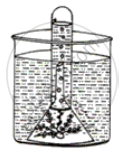Advertisements
Advertisements
प्रश्न
Assertion (A): All food chains begin with herbivores.
Reason (R): Green plants are heterotrophs.
विकल्प
A is True and R is False.
A is False and R is True.
Both A and R are True.
Both A and R are False.
उत्तर
Both A and R are False.
APPEARS IN
संबंधित प्रश्न
What is meant by photosynthesis? Why is it so important in nature?
An experiment was set up as shown in the figure alongside. Look at the figure and answer the following questions:
( i) What is the objective of this experiment?
( ii ) Which plant is used in this experiment?
( iii ) Which gas is evolved in this process?
( iv ) What will happen to the rate of evolution of this gas if a pinch of sodium
bicarbonate is added?
(v ) What will happen if the apparatus is kept in dark?

Name the following:
The category of organisms that prepare their own food from basic raw materials.
Name the following:
The organisms that can be called "natural purifiers" of the air.
Mention one difference between the following on the basis of what is given in bracket.
Grass and grasshopper (mode of nutrition)
The site of light reaction in the cells of a leaf is ______.
A candidate studied the importance of certain factors in photosynthesis. He took a potted plant and kept in the dark for over 24 hours. In the early hours of the next morning, he covered one of the leaves with black paper in the centre only. Then he placed the plant in sunlight for a few hours and tested the leaf which was covered with black paper for starch.
What aspect of photosynthesis was being investigated?
The figure below represents the vertical section of a leaf:

(i) Name the parts 1 to 5.
(ii) How many veins have been shown?
(iii) State the functions of parts 4 and 5.
Give technical term:
What does ATP abbreviate for?
Mention, if the following statement is True or False. If false rewrite the wrong statement in its correct form:
Leaves are broad and flat to increase the surface area for photosynthesis.
Column ‘II’ is a list of items related to ideas in Column ‘I’. Match the term in Column ‘II’ with the suitable idea given in Column ‘I’.
| Column I | Column II | ||
| (i) | Grana | (a) | Decomposers |
| (ii) | Autotrophs | (b) | Light reaction |
| (iii) | By-products of photosynthesis | (c) | Animals |
| (iv) | Photolysis | (d) | Oxygen |
| (v) | Bacteria and fungi | (e) | Stimulated by light |
| (vi) | Chloroplast | (f) | Power |
| (vii) | Oxygen and water | (g) | Raw material |
| (viii) | Sunlight | (h) | Machinery |
| (ix) | CO2 and water | (i) | End products |
| (x) | Glucose (sugar) | (j) | Workrooms |
| (xi) | Cells in the leaf | (k) | By-products. |
Answer the following question.
Explain why photosynthesis is considered the most important process in the biosphere.
Fill in the blank by rearranging the letter in the bracket.
Pigment involved in the food synthesis is _________ (phllylochor).
Gas exchange takes place in plants using _____.
Where does the carbon that is used in photosynthesis come from?
Oxygen is used for the synthesis of protein and fertilizers.
Read the following sentences about photosynthesis.
- Sunlight, carbon dioxide, chlorophyll and water are necessary.
- Oxygen is absorbed.
- Leaves carry out photosynthesis.
- Proteins are made during photosynthesis.
Choose the correct pair of sentences that are true to photosynthesis.
Plants may inhale carbon dioxide for photosynthesis but need ______ for their living.
Give an example for micronutrients.
Arrange and rewrite the terms in the group in the correct order to be in a logical sequence beginning with the term that is underlined:
Snake, Rabbit, Cabbage, Hawk.
